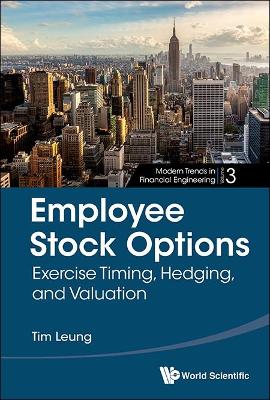Modern Trends In Financial Engineering
3 primary works
Book 0
Employee Stock Options: Exercise Timing, Hedging, And Valuation
by Tim Siu-tang Leung
Published 11 August 2021
Employee stock options (ESOs) are an integral component of compensation in the US. In fact, almost all S&P 500 companies grant options to their top executives, and the total value accounts for almost half of the total pay for their CEOs. In view of the extensive use and significant cost of ESOs to firms, the Financial Accounting Standards Board (FASB) has mandated expensing ESOs since 2004. This gives rise to the need to create a reasonable valuation method for these options for most firms that grant ESOs to their employees. The valuation of ESOs involves a number of challenging issues, and is thus an important active research area in Accounting, Corporate Finance, and Financial Mathematics.In this exciting book, the author discusses the practical and challenging problems surrounding ESOs from a financial mathematician's perspective. This book provides a systematic overview of the contractual features of ESOs and thoughtful discussions of different valuation approaches, with emphasis on three major aspects: (i) hedging strategies; (ii) exercise timing; and (iii) valuation methodologies. In addition to addressing each of these categories, this book also highlights their connections and combined effects of the cost of ESOs to firms, as well as examines the implications to modeling and valuation approaches. The book features a unique approach that combines stochastic modeling and control techniques with option pricing theory, and provides formulas and numerical schemes for fast implementation and clear illustration.
Book 1
Optimal Mean Reversion Trading: Mathematical Analysis And Practical Applications
by Tim Siu-tang Leung and Xin Li
Published 13 January 2016
Optimal Mean Reversion Trading: Mathematical Analysis and Practical Applications provides a systematic study to the practical problem of optimal trading in the presence of mean-reverting price dynamics. It is self-contained and organized in its presentation, and provides rigorous mathematical analysis as well as computational methods for trading ETFs, options, futures on commodities or volatility indices, and credit risk derivatives.This book offers a unique financial engineering approach that combines novel analytical methodologies and applications to a wide array of real-world examples. It extracts the mathematical problems from various trading approaches and scenarios, but also addresses the practical aspects of trading problems, such as model estimation, risk premium, risk constraints, and transaction costs. The explanations in the book are detailed enough to capture the interest of the curious student or researcher, and complete enough to give the necessary background material for further exploration into the subject and related literature.This book will be a useful tool for anyone interested in financial engineering, particularly algorithmic trading and commodity trading, and would like to understand the mathematically optimal strategies in different market environments.
Book 5
Multiscale Financial Data Analytics And Machine Learning
by Tim Siu-tang Leung and Theodore Zhao
Published 28 February 2025
Multiscale Financial Data Analytics and Machine Learning offers a systematic and comprehensive study on the multiscale approach to financial data analytics and machine learning. This book covers an array of multiscale methods to discover the properties of various timescales embedded in a financial time series, including noise-assisted empirical mode decomposition methods. Important interpretable multiscale outputs from the estimation are recognized as a new set of features that can be used for machine learning. The feature selection problem for machine learning is examined in this volume.This book offers an applied quantitative approach that combines novel analytical methodologies and practical applications to a wide array of examples with real-world data. It is self-contained and organized in its presentation. The explanations of the methodologies are both accessible and detailed enough to capture the interest of the curious student or researcher. Step-by-step descriptions of the algorithms are provided for straightforward implementation.


